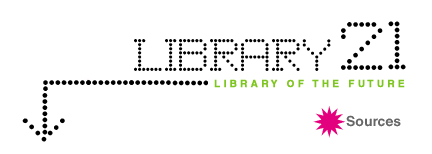
1. Hayes, R.M. (2002, March 11). Telephone interview.
2. Findlay, J.M. (1992). The Seattle World’s Fair of 1962: downtown and suburbs in the space age. In Magic lands: western cityscapes and American culture after 1940 (pp. 214-264). Berkeley : University of California Press. (p. 256)
3. Reynolds, M.E. (2001). The dynamics of change : a history of the Washington State Library. Pullman, Wash. : Washington State University Press. (p. 114)
4. Becker, J. (1961, January 26). 2d intermim report to the ALA Advisory Committee on Library-21. (University of Washington Archive. Seattle World’s Fair, Box 21, Folder: Library 21.) (pp. 10-11)
6. Cooper, Dorothy M. (n.d.) Memo. ( Irving Lieberman papers. University of Washington Archive. Seattle World’s Fair, Box 21, Folder: Library 21.)
7. Lieberman, I. (1962, April). Library 21: the dynamics of recorded knowledge and information. Stechert-Hafner Book News 16(8), 93-95. (University of Washington Archive. Seattle World’s Fair, Box 21, Folder: Library 21.)
8. Martin, G.P., Hayes, R.M., & Lieberman, I. (1963). Recruitment and training of staff and support of staff dissemination activities at the American LibraryAssociation, Library 21 exhibit, Seattle World's Fair, B-252. Seattle, Wash.: School of Librarianship, University of Washington. (p. 2)
10. Patterson, C.B. (1962, September). Seattle fair looks to the 21st century. National Geographic 122(3), 402-427. (pp. 412, 405)
12. Century 21 Exposition. Souvenir Program. (1962). Retrieved March 10, 2002, from: http://www.geocities.com/seattlescruff/LifeinSpaceAge.htm
13. Patterson, C.B. (1962, September). Seattle fair looks to the 21st century. National Geographic 122(3), 402-427. (p. 407)
14. Martin, G.P., Hayes, R.M., & Lieberman, I. (1963). Recruitment and training of staff and support of staff dissemination activities at the American LibraryAssociation, Library 21 exhibit, Seattle World's Fair, B-252. Seattle, Wash.: School of Librarianship, University of Washington. (p. 3)
17. Trezza, A. (1962, June). Library 21 opens. ALA Bulletin. 56(6), 561.
18. Fountain, J.W. (2001, August 23). Librarians adjust image in an effort to fill jobs. New York Times, A12.
19. Martin, G.P., Hayes, R.M., & Lieberman, I. (1963). Recruitment and training of staff and support of staff dissemination activities at the American LibraryAssociation, Library 21 exhibit, Seattle World's Fair, B-252. Seattle, Wash.: School of Librarianship, University of Washington. (pp. 9, 12-13)
20. Vagianos, L. (1962, December). Librarians, librarianship, and library 21. Wilson Library Bulletin 37, 334.
21. Licklider, J.C.R. & Taylor, R. (1968). The computer as a communication device. Science & Technology 76. Retrieved March 31, 2003, from: http://memex.org/licklider.pdf
22. Buck Rogers was a science-fiction hero first introduced in a novelette by Philip Francis Nowlan published in the August 1928 issue of Amazing Stories, then popularized in a comic strip drawn by Alex Raymond, who also created Flash Gordon. Buster Crabbe played both of these heroes in 1930s films, and the character has reappeared periodically on television and in the movies.
23. Hayes, R.M. (2002, March 11). Telephone interview.
24. Shera, J.H. (1971). Daedalus, Icarus, and the technological revolution. In "The compleat librarian"; and other essays. Cleveland, Ohio. Press of Case Western Reserve University. (p. 64)
25. Wilson, E.O. (1998) Consilience: the unity of knowledge. Thorndike, Maine, Thorndike Press [large print ed.].
26. Hayes, R.M. (2002, August 19). "Re: Library 21 on the Web." E-mail to the author.
28. Wakeman, J. (1962, December). The context of librarianship. Wilson Library Bulletin 37, 348.